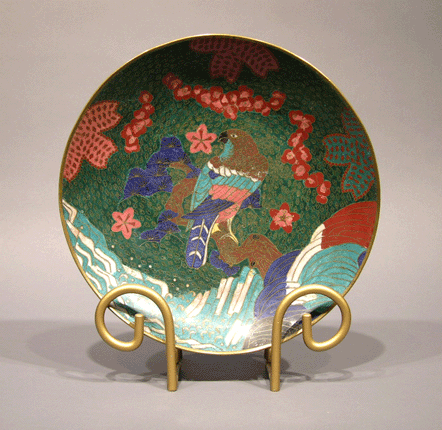
Edo period (1800-1868). Important for its age, motifs, glaze, and the way it was made.
12¼” h 12¼” w 1¾” d
This charger is quite old and rare. It is hard to pin down the age of old Japanese pottery art because in Edo period, they were considered properties of the daimyos and the artisans working under them were not allowed to put their name or seal on anything they created. The rare motif of falcon on enamelware suggests this piece was made during Japan’s feudal state when falconry was enjoyed by Daimyos. The dark green enamel background and Ming-influenced curling cloud design also help to corroborate the age of the piece.
Historically the important name is Kaji Tsunikichi of Owari (1803-1883), who was trained as a samurai, but with decline of the Feudo system, to make a living, he decided to venture into the art of cloisonné-making, made popular under the Chinese emperor Quanlong (1735-1795). To start, he broke a Chinese plate into half to learn the secret of cloisonné-making. The result of his effort was producing small pieces, copies of Ming ware, which caught the interest of the Shogun. By the middle of the 19th century, many of his students were engaged in cloisonné manufacturing and Kaji is credited with the incarnation of Japanese cloisonné production.
From the beginning, many objects were made of thin, hammered brass wire. To give the shape more stability, the objects were decorated with enamel on both sides. The wires between the enamel-filled cells were made of bronze hammered flat for a long time, resulted in split wires. These wires were soldered on. This plate appears to have split wires that were soldered on, and like early cloisonné, has a matte, uneven finish. Other evidence of old age is the presence of many tiny pits, caused by gas escaping from bronze when it was heated in the furnace. Later, mostly copper was used as it was less affected by this problem. Important on this period is the monochrome glazes. The bottom of this plate has the rough “snake-skin” green glaze.
The designs and colors on this plate also help to shed light on its age. Like early Japanese cloisonné, this plate used the somber dark color for the background instead of bright turquoise of a later date. Another early mark is the filling in of open spaces with spiral cloud designs. The curling style is of Japanese Mid-Edo (1750-1800), which resembles the cloud design of Ming Dynasty. The colors of this plate are all basic early enamel colors. The dark green background is beautifully set off by motifs in brilliant turquoise, cobalt-blue, cinnamon red, and “Ming pink”. The motifs of prunus, paulownia and chrysanthemum flowers, clouds, waves and mountains are both Chinese and Japanese. The last three motifs together symbolize the emperor’s rule over his domain. This is a piece worthy of further discussion by cloisonné experts as it used to belong to a teacher of cloisonné-ware from China. He feels this piece belongs in an art institute or museum for study.